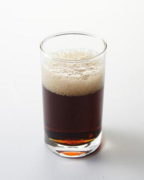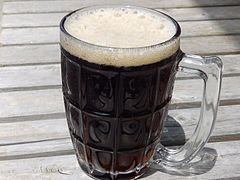Cookbook:Soda Pop
| Soda Pop | |
|---|---|
 |
Cookbook | Recipes | Ingredients | Equipment | Techniques | Cookbook Disambiguation Pages | Ingredients
Soda pop, commonly called soda or pop (esp. in Canada), is a sweetened and carbonated nonalcoholic beverage.[1][2] It is a type of soft drink distinct from juices or flavored waters.[3]
Characteristics
[edit | edit source]At its most basic, a soda typically consists of a sweetened flavored base that is mixed with carbonated water. This base often takes the form of a very concentrated syrup, juice, or extract. The sweetener can be either sugar-based or, in the case of diet soda, non-sugar based.[3] The flavoring can be natural or artificial. In many cases, the precise components of commercial sodas and their ratios are trade secrets.[3] However, flavor extracts and oils are common, as is acidity to balance the sweetness.[3]
Sodas are typically available in cans, bottles, or straight from a soda fountain in a food establishment.[2][3]
Cola
[edit | edit source]Colas are typically dark brown in color, with an ambiguous flavor that differs from maker to maker.[4] Some contain kola nut extract, which is an original namesake of this soda variety.[5]
Cream soda
[edit | edit source]Cream soda is typically flavored with vanilla and/or caramel.[2] Despite the name, it usually contains no cream or other dairy products.[2]
Fruit soda
[edit | edit source]Fruit sodas are a large category. Citrus flavors in particular are popular and widespread, with lemon-lime being a classic.[1] Orange, cherry, and grape are also common, and regional flavors can include apple, guava, mango, and more.
Ginger ale and beer
[edit | edit source]As implied, ginger ale is primarily flavored with ginger and comes in both sweet golden and dry types.[1] Golden varieties are sweeter and stronger in flavor, while dry varieties are less so.[1] Ginger beer is very similar to ginger ale, but it is considered spicier and less sweet.[1]
Root beer
[edit | edit source]Root beer's flavor is dominated by notes of licorice, which can come from sassafras, sarsaparilla, anise, etc.[1][4] The soda is usually brown in color and generates a lot of foam when being poured.[1]
-
Cola
-
Lemon-lime soda
-
Root beer
-
Ginger ale
-
Grape soda
-
Cream soda
Selection and storage
[edit | edit source]Soda may be sold in cans, glass bottles, or plastic bottles, all of which are highly shelf-stable at room temperature. However, soda in plastic bottles can gradually lose some carbonation over a long period due to the porosity of plastic. No matter the container, avoid shaking or jostling it, since this can build up pressure and either burst or make a mess when opened. Soda is best consumed cold, which helps preserve the carbonation and prevents it from tasting overly sweet.
Use
[edit | edit source]The most common application for soda is as a beverage, either consumed on its own or as a part of a hard or soft mixed drink.[1] One popular blend consists of soda and ice cream, which combine to produce an ice cream float.[1] Some popular soda-based hard drinks include the rum and coke, Long Island iced tea, rooster, etc.[1]
Sodas may also be used in cooking and baking, where they contribute sweetness and acidity.[4] For example, cola may be used in a meat marinade or reduced to make a glaze,[6] and other sodas may be incorporated into cakes.[4]
A basic soda can easily be made at home by combining a simple syrup with carbonated water. Adjust the flavors of the simple syrup and add coloring as desired to produce a range of varieties yourself.[1]
Recipes
[edit | edit source]References
[edit | edit source]- ↑ a b c d e f g h i j k "Use the Right Soda for Your Mixed Drinks". The Spruce Eats. Retrieved 2024-05-07.
- ↑ a b c d Kipfer, Barbara Ann (2012-04-11). The Culinarian: A Kitchen Desk Reference. Houghton Mifflin Harcourt. ISBN 978-0-544-18603-3.
- ↑ a b c d e Goldstein, Darra (2015-01-01). The Oxford Companion to Sugar and Sweets. Oxford University Press. doi:10.1093/acref/9780199313396.001.0001. ISBN 978-0-19-931339-6.
- ↑ a b c d Nast, Condé (2015-07-14). "Give Your Cooking a Pop With This Secret Ingredient". Epicurious. Retrieved 2024-05-07.
- ↑ "The little-known nut that gave Coca-Cola its name". www.bbc.com. Retrieved 2024-05-08.
- ↑ "What you should (and should not) cook with Coca-Cola". Southern Kitchen. Retrieved 2024-05-07.






